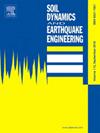Seismic performance of Li-Tie type brick masonry infilled wooden frames considering joint damage: Degradation mechanism and hysteretic model
IF 4.2
2区 工程技术
Q1 ENGINEERING, GEOLOGICAL
引用次数: 0
Abstract
This paper investigated the influence of the damage to column-foot (C-F) joints and the gaps of mortise-tenon (M-T) joints on the seismic behavior of Li-Tie style timber frames with masonry-infilled wall. Five full-scale Li-Tie type brick masonry-infilled timber frames, two without the joint damage, two with the damage to C-F, and one with the gaps of M-T joints, were cyclically tested. The failure modes, mechanical and deformation mechanisms were revealed. The second-order effect, strength degradation law, and the changing laws of the equivalent viscous damping coefficient and strain of the specimens were analyzed. The results showed that when the maximum inter-layer drift ratio was less than 2.4 %, the second-order effect of Li-Tie type timber structure with the masonry infill can be ignored. The masonry infilled timber frames considering the joint deterioration suffered a large strength degradation degree, and a more significant loss of the peak load and ductility. The equivalent viscous damping coefficient of the masonry infilled timber frame considering C-F damage increased by up to 24.67 %, while that of the one including the gaps of M-T joint decreased by 6.67 %. The C-F damage led to an increase in the strain at the beam end, the damage to M-T joint resulted in an decrease in the strain at the beam end. However, the damage to C-F and the gaps in M-T joint had little influence on the strain distribution in the C-F area. Based on the hysteretic, stiffness and strength degradation characteristics, and tests results of the specimens, the new tri-linear hysteretic models of Li-Tie type brick masonry infilled wooden frames with and without the joint damage were established and verified. Good agreement between the model predictions and test results was observed.
考虑接缝破坏的 Li-Tie 型砖砌体填充木框架的抗震性能:退化机制和滞后模型
本文研究了柱脚(C-F)接缝损坏和榫卯(M-T)接缝间隙对砌体填充墙 Li-Tie 型木结构抗震性能的影响。对五种全尺寸的锂铁式砖砌体填充木框架进行了周期性试验,其中两种框架的接缝没有损坏,两种框架的 C-F 接缝有损坏,一种框架的 M-T 接缝有间隙。试验揭示了破坏模式、力学和变形机理。分析了试样的二阶效应、强度退化规律以及等效粘滞阻尼系数和应变的变化规律。结果表明,当最大层间漂移比小于 2.4 % 时,带砌体填充物的 Li-Tie 型木结构的二阶效应可以忽略。考虑了接缝劣化的砌体填充木结构强度退化程度较大,峰值荷载和延性损失较明显。考虑 C-F 损伤的砌体填充木框架的等效粘性阻尼系数增加了 24.67%,而包括 M-T 接缝间隙的砌体填充木框架的等效粘性阻尼系数则降低了 6.67%。C-F 破坏导致梁端应变增加,M-T 连接破坏导致梁端应变减少。然而,C-F 的损坏和 M-T 接头的间隙对 C-F 区域的应变分布影响不大。根据试件的滞回、刚度和强度退化特征以及试验结果,建立并验证了有和无接缝损坏的锂铁砌体砖填充木框架的新三线性滞回模型。结果表明,模型预测与试验结果之间具有良好的一致性。
本文章由计算机程序翻译,如有差异,请以英文原文为准。
求助全文
约1分钟内获得全文
求助全文
来源期刊

Soil Dynamics and Earthquake Engineering
工程技术-地球科学综合
CiteScore
7.50
自引率
15.00%
发文量
446
审稿时长
8 months
期刊介绍:
The journal aims to encourage and enhance the role of mechanics and other disciplines as they relate to earthquake engineering by providing opportunities for the publication of the work of applied mathematicians, engineers and other applied scientists involved in solving problems closely related to the field of earthquake engineering and geotechnical earthquake engineering.
Emphasis is placed on new concepts and techniques, but case histories will also be published if they enhance the presentation and understanding of new technical concepts.
 求助内容:
求助内容: 应助结果提醒方式:
应助结果提醒方式:


